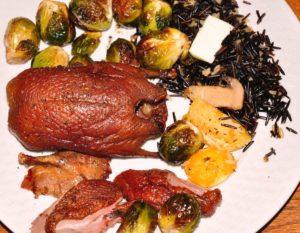Photography courtesy of Lowell Washburn, all rights reserved.
Iowa’s second installment in a series of three year, experimental Early Teal Seasons has concluded. Timed to coincide with peak migrations of blue-winged teal, the September hunt was reauthorized by the U.S. Fish & Wildlife Service in 2014. The season has been offered to Iowa waterfowlers as a 16-day free bonus and does not subtract days from the state’s regular 60-day duck season.
DNR Conservation Officers reported strong hunter turnout and good teal numbers across most of Iowa as the 2015 season kicked off Labor Day Weekend. Officers noted that teal numbers were greatest in the north central and northwestern regions of the state where hunter success ranged from good to excellent.
In spite of a lingering heat wave, success remained good through most of the first week as migrating teal continued to invade the state. On Thursday [Sept. 10] a much welcomed cold front moved across the region. But although the front did move large numbers of teal, it was not in the way hunters had hoped. The slate was virtually wiped clean as wholesale numbers of blue-wings flew south with few birds moving in from the north to fill the void. For the remainder of the season, the migration proceeded at a trickle with most hunters bagging one to four teal per outing.
I was able to hunt on 15 of the season’s 16 days. I bagged slightly less than half the number of teal I brought home during the 2014 season, which was typical for the hunters I’ve talked to. But regardless of whether the bag numbers were up or down, I still enjoyed the privilege of viewing 15 sunrises from a duck blind, enjoyed close hand observation of many wildlife species, and still got to eat plenty of roast teal. The hunting may not have been as phenomenal as last year, but I had a ton of fun just being out in the marsh. The thing all hunters need to keep in mind is that each and every early teal is a bonus; a completely free addition to the 60 days we’ll all be enjoying during the upcoming regular duck season.
_________________________________________
Compromised Habitat; Reduced Opportunities: One of the things that really stood out about this year’s special teal season was how the “feast or famine” scenario played out to an exaggerated extreme with the majority of ducks using a scant handful of available wetlands. There is little mystery as to why that happened. Blue-winged teal prefer shallow, food rich wetlands and those habitats were almost nonexistent this year. Following torrential rainfalls in late August, traditional teal hunting areas in North Central Iowa, for example, have exceeded crest level or been at flood stage, offering little incentive for migrating blue-wings to linger. Wetlands that contained six or eight inches of water last fall are now better suited to water skiing than to duck hunting.
Last September, I enjoyed daily success on a public marshland holding four inches of water and tons of natural food sources in Cerro Gordo County. This year, the same area remains at flood stage; buried in more than three feet of water. Even a Canada goose can’t reach bottom in the same spot where shorebirds gathered and teal came to guzzle duckweed and invertebrates last season. This year, fowl of all types are avoiding the spot like the plague. Hopefully, our wetland habitats will be more desirable to early migrants next fall.
Migrating teal have apparently found better habitat conditions farther down the flyway. Louisiana’s early teal season runs from Sept. 12 thru Sept. 27 and Southern hunters are flying high. According to Louisiana Waterfowl Study Leader, Larry Reynolds, desirable habitat conditions have led to an incredible buildup of migrating blue-wings so far. Louisiana teal numbers further escalated as new birds continued to arrive in the state following the Sept. 10 cold front; the same front that triggered the mass exodus from Iowa. The latest waterfowl count tallied more blue-winged teal in Louisiana this year than the 2013 / 2014 surveys combined. Hunter success has remained “good” for the first few days of the season.
So how “good” is good? A recent update posted by Ducks Unlimited reports that waterfowl enthusiast, Cory Smith [along with three friends] has been doing well on a shallow crawfish pond near Jennings, La. As teal swarm, the party has been consistently bagging four- man, 24-duck limits each day. The longest they’ve had to hunt so far was 6:55 am, said Smith — meaning the group has bagged full limits of teal during the first few minutes of each morning. From where I sit, I’d have to agree that Louisiana duck hunting does sound pretty “good”.
____________________________________________________
P.S. — Let me know how your teal season went.
LW
Sept. 21, 2015





 Susan Judkins Josten
Susan Judkins Josten Rudi Roeslein
Rudi Roeslein Elyssa McFarland
Elyssa McFarland Mark Langgin
Mark Langgin Adam Janke
Adam Janke Joe Henry
Joe Henry Sue Wilkinson
Sue Wilkinson Tom Cope
Tom Cope Kristin Ashenbrenner
Kristin Ashenbrenner Joe Wilkinson
Joe Wilkinson Dr. Tammy Mildenstein
Dr. Tammy Mildenstein Sean McMahon
Sean McMahon